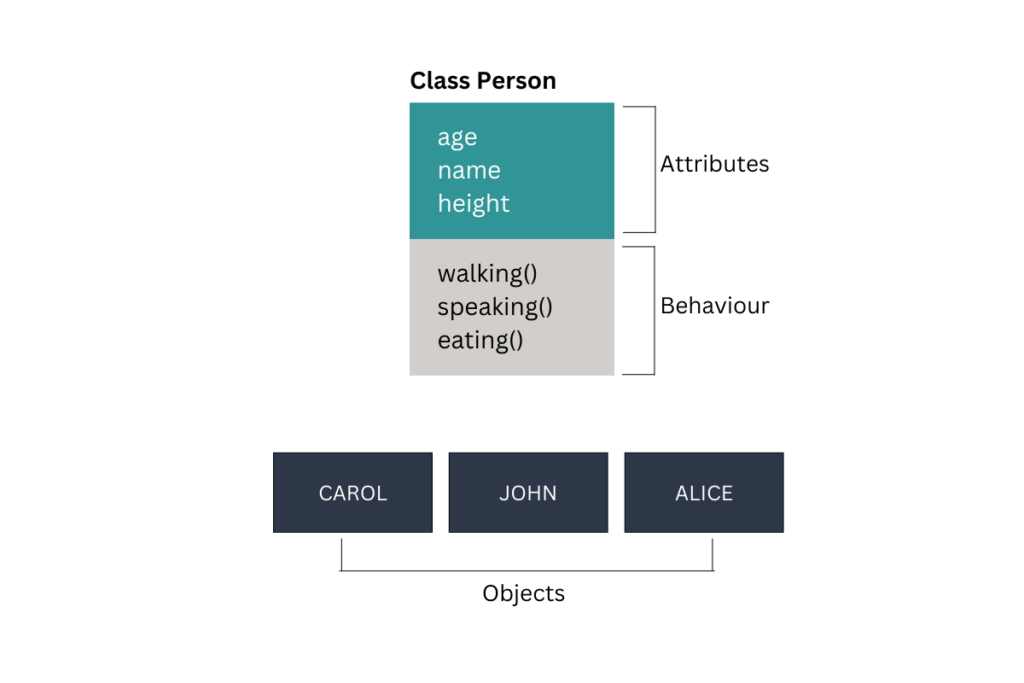A class is a blueprint or a template for creating objects. It defines the properties (attributes) and behaviors (methods) that an object will have.
Like an architect who first makes a design before constructing a building, the class concept is similar to that of an architect. The building design represents a class, and the buildings are the objects.
Let’s understand this with an example: Suppose we have a person named “CAROL.” This person has some properties like age, name, height, and color, and behaviors like walking style, speaking style, and eating style. Carol is an object, and the class(Person) is like a blueprint that defines what properties and behaviors a person can have.
In this case, the Person class would define attributes (age, name, height) and methods (walking, speaking) that all people (objects) like Carol will share. Objects are created from the class. We can create multiple objects with the help of class
For example, if we have a class Person, we can create objects (instances) like Carol, John, or Alice. Each object will have its own values for the attributes (e.g., Carol’s age might be 25, while John’s age might be 30

Similarly, we can create classes like Computer and Employee, each with their own attributes and behaviors. For example, a Computer class may have attributes like brand, price, processor, and RAM, with behaviors like starting up or shutting down. An Employee class may have attributes like name, employee ID, and salary, with behaviors like working or taking a break.

Structure of a Java class
The structure of a Java class is also called the class definition. We cannot write a Java program without a class definition because every Java program must have at least one class. This structure is divided into two parts: the first part is the class header, and the second part is the class body.

Explanation:
The structure of a class contains the class header and the class body, as shown in the diagram above. The class definition refers to the overall structure of the class, including its name, fields (attributes), methods (behavior), and any constructors.
Class Header:
In the class header, we use the class keyword followed by the class name, which should be meaningful and written in CamelCase format.
Modifiers can also be included in the class header. A modifier is written before the class keyword. If no modifier is specified, the default access level for a class is package-private, not public. This means the class is accessible only within its own package.
Example:
public class MyClass { // Public modifier before the class keyword
// Class body
}
Class Body:
The class body starts and ends with curly braces ({}). It contains the following elements:
- Field Declarations: These are variables that hold the state of an object.
- Method Declarations: These define the behavior of the class, including functions that can operate on the class’s fields.
- Other Declarations: This includes constructors, initializers, and any nested classes or interfaces.
public class ExampleClass { // Class header
// Field declarations
private int age;
private String name;
// Constructor
public ExampleClass(int age, String name) {
this.age = age;
this.name = name;
}
// Method declaration
public void displayInfo() {
System.out.println("Name: " + name + ", Age: " + age);
}
} // Class body ends here
Benefits of using classes in Java
- Encapsulation: Classes allow you to bundle data (attributes) and methods (functions) together.
- Reusability: Once a class is defined, it can be instantiated multiple times to create objects.
- Abstraction: Classes provide a way to represent complex systems through simplified models.
- Inheritance: Classes support inheritance, allowing one class (subclass) to inherit properties and methods from another class (superclass).
- Polymorphism: Java classes support polymorphism, enabling objects to be treated as instances of their parent class.
- Maintainability: Organizing code into classes makes it easier to manage and update.
- Clear Structure: Classes help organize code logically, making it easier to read and understand.
Conclusion
In conclusion, a class in Java is a blueprint for creating objects, and defining their properties and behaviors. It allows developers to model real-world entities and promotes code reusability and organization. By understanding classes, programmers can create efficient and maintainable applications, making it a fundamental concept in object-oriented programming. Embracing classes is essential for effective Java development.
We’d Love to Hear From You!
Do you have questions or feedback about the class concept in Java? We’re here to help! Whether you need further clarification, have suggestions, or just want to share your thoughts, please leave a comment below. Your feedback is invaluable in helping us improve our content and support others. Don’t hesitate to reach out—we’re excited to hear from you!
If you want to learn about loops then click while loop, do while, for loop, foreach loop.